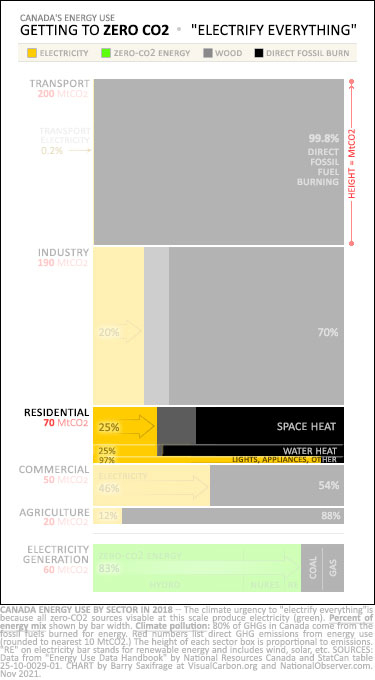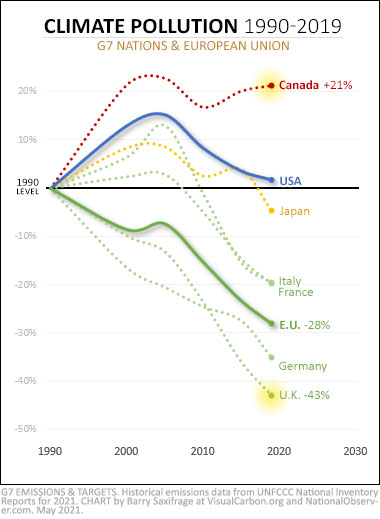Support strong Canadian climate journalism for 2025
This is the final instalment in a three-part series on "Electrify Everything" in Canada. Part 1 covered the national trends. Part 2 dug deeper into the transportation sector. This one covers one of our most electrified sectors: Residential buildings.
In the first part of this series, I looked at the climate urgency to "electrify everything" and how Canada's done so far.
Summary: Fossil fuel use in Canada has been surging faster than overall energy use. That's increased Canada's dependency on fossil fuel burning from 70 per cent in 2005 to 74 per cent now. In contrast, Canadian electricity use has fallen to just 20 per cent of our energy use. Instead of "electrifying everything" — as required to stop the climate crisis — we're busy de-electrifying.

That's according to data in National Resource Canada's Energy Use Data Handbook, which covers the years 2000 to 2018.
I used that same data to create this "Electrify Everything" overview chart. It shows the energy mix and emissions for each sector in Canada's economy.
In my first article, I briefly walked through this chart, sector by sector, plus gave a summary of our electricity generation.
In this article, I'm going to take a closer look at one of our most electrified sectors, residential buildings.
As the chart shows, a little over a third of the energy used in Canadian homes is electricity, while half comes from burning fossil fuels — mostly methane gas. Most of the rest is firewood.
Digging deeper
The government's data divides residential energy use into three areas: space heating, water heating, and everything else.

Most of the energy used, and most of the climate pollution emitted, comes from heating air.
Water heaters are the next biggest source of climate pollution from Canadian homes. As with space heating, only a quarter is electrified.
The good news is that millions of Canadian homes are already fully electric, including space and water heating. So, this isn't a climate task requiring miracle technology breakthroughs or futuristic fuels. Heating with electricity is common and has been for decades.
The bad news is that despite zero-emissions buildings being common and critical to the climate fight, most Canadians continue to burn fossil methane in their homes.
Home energy trends
Fossil methane burning dominates both space and water heating in our homes. Even more problematic, Canadians keep turning up the burn.

My next chart shows the trends since 2000 for the fossil methane gas, fossil oil and electricity used for heating.
Heating demands fluctuate annually depending on how cold our winters are. The gray dotted lines on the chart show this jittery annual data. The solid lines on top show the linear trends.
One bright spot is that Canadians are burning less fossil heating oil.
But that climate progress has been offset by a steady rise in the amount of fossil methane gas that is burned in our homes. In 2018, fossil methane burning set a new record, breaking the 200-terawatt-hour (TWh) mark for the first time.
In many Canadian cities, the biggest source of climate pollution is the fossil methane burned in buildings. So reducing fossil methane burning is the most critical climate task most cities face.
The hopeful news, as noted above, is that the technology to electrify buildings is common and widespread. Millions of Canadian buildings are already 100 per cent electric. I live in one. I'm sure many of you do as well.
But that seeming advantage in the climate fight is being overwhelmed by a dramatic shift in energy prices.
Home energy pricing and policies
My chart below shows the handbook's data for average residential energy prices in Canada. Take a look at the gigantic price gap that has opened since 2005. That's the baseline year for our Paris Agreement climate targets.

As the chart shows, back in 2005, the average price of electricity was almost twice as much as fossil methane gas. Now electricity costs four times more than burning fossil gas.
How will Canadians electrify our homes in time to prevent a full-blown climate crisis when our governments' policies allow the economic incentives to move so strongly in the opposite direction? What Canadians need are climate policies that make it cheaper to choose climate-clean energy instead of dirty energy.
Consider that it takes $50 per tonne of CO2 in carbon taxes to add one cent to a kWh of fossil methane gas. As the chart shows, fossil methane gas prices have fallen by two cents since 2005. This two-cent decline has acted as a reverse carbon tax — a CO2 rebate — making it $100 cheaper to emit each tonne of CO2. Canadian climate policy has allowed it to become much cheaper to pollute our climate. This has created financial incentives to pollute more. Which is exactly what Canadians are doing.
At the same time that Canadian climate policy allowed it to get much cheaper to emit CO2, it has doubled down on climate failure by also allowing the cost of the required alternative — electricity — to get more expensive. This double pricing failure has created significant economic incentives to not "electrify everything."
Sure enough, fossil methane burning in Canadian homes continues to rise to record-breaking heights.
It doesn't have to be like this. Canada could enact climate policies that, at the very least, level the playing field between our clean electricity and climate-destabilizing fossil.
Canada's carbon tax to the rescue?
Will Canada's new carbon tax do that? Unfortunately, it will only rise to $50 per tonne of CO2 by 2022.
As mentioned above, that will add just one cent per kWh to fossil methane prices. To return the price gap with electricity back to what it was in 2005 would require a $250 carbon tax.
While $250 per tonne of CO2 might sound like a lot, consider that many of our peer nations — the U.K., Germany, and France — tax fossil gasoline $400 higher per tonne of CO2 than we do. So, it's not like we are paying very much for our climate pollution in Canada.

This ongoing failure of Canadian governments to price CO2 pollution effectively has created financial incentives for Canadians to keep on climate polluting. And we have.
That's contributing to Canada having the worst climate record by far among our G7 peers.
We've been promising to reduce our oversized climate pollution for decades. Isn't it time we joined our peers and started doing it?
Doing it will require shutting off our fossil burning and electrifying everything instead.
If you're lucky enough to be a Canadian homeowner and want to help, one key thing you can do is to stop buying anything new that burns fossil fuels. When you replace your furnace, water heater or stove, choose one that runs on Canadian-made electricity.
Every time a new fossil fuel burner gets installed in a Canadian home, it locks in decades of future climate pollution. And it locks out the chance to electrify our homes for decades. We no longer have decades to waste if we are going to do our part in avoiding a full-blown climate crisis.
------------------------
"Electrify Everything" series summary — Here's a quick cheat sheet of the main points covered in this three-part series.
- We need to "electrify everything" — The climate crisis is creating an urgency to "electrify everything" in Canada. That's because electricity carries all our zero-emitting, climate-safe energy. The choice today is either to plug in or burn. Fortunately, Canadian electricity is already one of the climate-cleanest in the world, with 83 per cent from zero-emitting sources. Emissions have fallen rapidly, and policies are on the books to continue this.
- But Canada is de-electrifying as fossil fuel burning surges — Fossil fuel burning in Canada has increased 10 times more than electricity use since 2005. That's pushed fossil burning up to 74 per cent of our final energy use while pushing electricity use down to only 20 per cent. And fossil burning dominates every Canadian sector, except electricity generation.
- Transportation is our deepest climate hole — Transportation is our most climate-polluting sector, emitting 200 MtCO2 per year. It is also our least electrified, at a fraction of one per cent. Fossil fuel burning in the transport sector has increased 420 times more than electricity since 2005. Canada's policies encourage this by making it hundreds of dollars cheaper to emit each tonne of CO2 out our tailpipes than in most OECD and G7 nations. Making it much cheaper to climate pollute creates incentives for Canadians to buy more climate-polluting passenger vehicles. Which we do. And it also reduces the incentive for Canadians to choose an electric vehicle instead. And that's what is happening as Canadians buy fewer EVs than our peers in nations that make climate polluting more expensive.
- Canadian homes are cranking up the fossil methane burn — The residential sector is one of Canada's most electrified at 38 per cent. But fossil methane burning still dominates and continues to rise. A major reason is that Canadian policy has allowed the cost to climate-pollute with fossil methane to fall by $100 per tonne of CO2 since 2005 — and the cost to use electricity to rise. As of 2018, the exploding price gap reached the point where electricity costs four times more per kWh than fossil methane. In Canada, it is increasingly cheaper to climate pollute in our homes than not to.







Comments
Looking at the price difference only doesn’t present the full picture. Electric heat pumps are 100-300% more efficient than furnaces, which means the gap in *energy bills* is less of a hurdle than the gap in prices.
Indeed. Still, it would be nice if the gap went the other way.
It would also be good if our zoning laws required all new homes (and offices etc. for that matter) to be built with electric heating rather than fossil fuel heating. Some municipalities are moving to that.
It would also help if dual energy companies like fortis, who supply electricity and natural gas, offered subsidies for installing heat pumps, rather than offering subsidies for new natural gas furnaces.
As pointed out above, heat pumps use far less energy to generate heat than gas furnaces, so one ends up paying less for the heat energy delivered to a house. This is the story journalists should be telling with graphs.
We could have illegalized gas for new neighbourhoods years ago, and immediately should. Move on to requirements that if your furnace needs replacing, you can't, you have to switch.
I'd also push for a neighbourhood-by-neighbourhood conversion plan, with "neighbourhood" defined by the natural gas network. Find their pressure zones, their sections of gas network where a single valve-turn blocks off whole streets - the final "leaves" on their tree of gas distribution. You subsidize switchovers for the whole group, turn the gas valve for their zone, and no gas goes in there ever again.
That maximizes the returns on the conversion - otherwise, you're asking the gas company to keep maintaining pipes to a neighbourhood, when at some future point only a minority - finally just a few percent - of the neighbourhood is paying gas bills. Better to do them all up front, and have one less kilometre of pipe to maintain.
I'm not quite sure where this commentary is drawing it's references from. I am all for alternatives to natural gas heating, but they aren't easy to come by. If you use electricity to heat your home, very commonly in much of the country that electricity is going to come from a power station that uses natural gas (or even coal) to fire it's boilers , they produce steam which drives turbines and generators. Efficiency of that electrical generation will be of the order of 98 percent, then you'll have some transmission losses getting that electricity to it's downstream uses. So natural gas will have been very much part of that supply of electricity... unless the power station is nuclear perhaps. Contrast that to the use of methane-natural gas in the home to fire the furnace... most jurisdictions require high efficiency furnaces be installed... they'll convert that natural gas to heat at 95 percent efficiency or better. So no huge differential using electricity to heat the home to using natural gas... similar amounts of gas will have been burned to produce the same amount of heat delivered to the home. That's necessary to say, simply in the name of intellectual honesty.
Heat pumps are certainly efficient (if you have an available warm water source lets say), .... water source or ground source heat pumps are required in virtually all of Canada (ambiant air temps in winter are very often too cold to use air-source heat pumps).... they are very expensive systems indeed (especially ground source pumps, and water source pumps are unfeasible except in multi-dwelling occupancies where you can put a cooling tower on the building's roof and a boiler in the mechanical room) ... financially out of reach of most Canadian families. You could use a hot water heater to provide a warm water source conceivably to the coaxial-water coil of the heat pump but then of course you'd be burning some natural gas to warm that water. This discussion above seems to missing a few things.
I work in HVAC-refrigeration. So I'm talking with reference to systems that are ubiquitous. I'm open to contrasting information if anyone can reference sources for consideration.
I need to add a further comment. There is a claim here that heat pumps somehow are up to 300 percent more efficient than gas furnaces. This is incorrect. There is no 'free lunch' when it comes to energy. Specifically when it comes to the creation of heat. Heat pumps are essentially refrigeration systems. The reason that a heat pump is "cheaper to run" than for example a purely electric heater-fan (..resistive heating..) type furnace system is that the heat pump scavenges-takes heat from a 'source'... it can borrow heat from the air outdoors (but only in a mild enough climate) , from deep in the ground (which involves circulating a fluid in piping, using a pump, down very deep into the ground to a heat exchanger buried there) or from a similar fluid loop-heat exchanger plumbed to make continuous direct contact with a warm enough water source (like water deep in a lake), or water pre-warmed by a HWT or a boiler. The heat that is scavenged from the source is then picked up by freon or refrigerant in a heat exchanger, that pre-'warmed' freon is then put through a mechanical compressor, which is of course run by electricity.... the freon leaving the compressor is boosted in heat content (temperature) by that compression cycle. That compressed hot freon is then routed to another heat exchanger which is essentially a radiator in a duct.... air is blown through the radiator and the warmed resulting air is delivered to one's dwelling or space. So purchased energy to run a heat pump is used to operated the compressor, but very conceivably to warm up water too.... that energy is not free, it must be purchased in one form or another.... quite conceivably it would need to be in the form of either natural gas, or additional electricity to warm up the water for the water-source part of the heat pump system... most people of course don't have a nearby lake or hot-spring. So heat pumps are NOT more efficient than furnaces. That's very inaccurate, it's a distortion of operational facts. And they absolutely are not cheaper to run than furnaces, at least not at this juncture. Electricity in most jurisdictions is more expensive to purchase than natural gas. This may of course change.